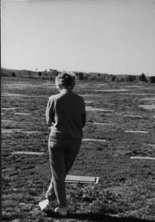The New Song Book
Chapter One: The Iron Duke
My father was raised on farms in upper northwest Iowa, first in Salix and then in Akron, first a few miles south and then north of Sioux City, just south of the South Dakota and east of the Nebraska boarders. The youngest male and next to the youngest of 12 offspring, Roger Lamoureux was born January 28, 1917. The family spoke a lot of French in the home; it is said that the children were not strong English speakers when they first entered school and that their father spoke mostly French at home on the farm.
The 4th child, Lorette, died as the result of a kitchen accident, cut down at 7 years young, the victim of a spilled pot of boiling soup. The other 11 children lived long into adulthood.

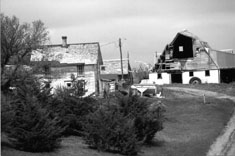
The Lamoureux’s started farming before the turn of the century and although life on a remote Iowa farm in the 1920s and 30s was hard work, the family was able to weather the Great Depression without suffering. Long hours brought lots of good food to the Lamoureux table.

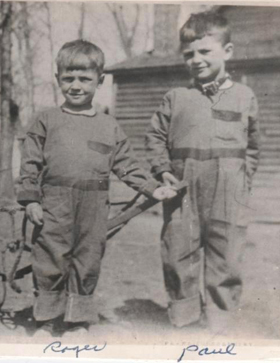
Brothers Lamoureux
Roger left, Paul right
First as young boys, then as adult men in the Navy
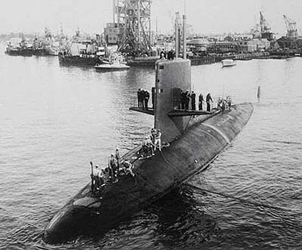
During his time in the Navy, Roger served, first, on an aircraft carrier, then a destroyer and finally, for 14 years, on submarines. His time under water spanned WWII, the Korean War, and concluded with 1956-57 spent on the secret “WESTPAC” surveillance missions around Japan. Submarine service points to a key feature about my dad: It takes a lot of calm to sit on the ocean floor, in a boat with hardly enough room to stand up straight and never the space to lay perpendicular to the boat’s short, straight line, while depth charges go off all around the hull. Many submariners played cards; Roger played better than most, and mostly, they played poker and cribbage. He told of playing to the light of a single flashlight, while Japanese depth charges sought to produce a boat-load of dead US sailors, with one added feature: The men at the table took side bets with each other as to how close the depth charges would get when detonated. After waiting out the raid and rising to the surface, for required and much-appreciated fresh air, the men checked with the radar/sonar operator to settle up the “guesstimate” wager. Eventual Chief of the engine room (diesel engines back then) Roger Lamoureux won his share of booty and developed adroit facility with card games of all stripe.
Just before WWII, Roger was offered a chance to apply to the Naval Academy at Annapolis, with the promise of a favorable recommendation from his superior officers. Not yet having completed high school via the GED program, action that he’d take while still in the service in 1949-1950), he felt academically inadequate, so refused to apply. He was, of course, no dummy. But he loved the life and sea, WW II was about to begin, and he was good at his job. A few years later, Roger was offered a promotion to the Officer Corps based on his excellent leadership and duty. But it was difficult for an Iowa farm boy to think of himself as Navy officer material and, most of all, he worried that joining the Officer Corps would alienate the enlisted men he led in the engine room. Although Roger held the Officer Corps in high esteem throughout his life, he never stated any regrets for not joining their ranks.
After WWII, Roger visited his family in Sioux City, including his father, Arthur, who had moved into town not long after Roger left the farm for the Navy. While visiting on leave, Roger came back to the upstairs apartment to find Arthur dead on the floor. Within the year, Roger had returned (just north of Sioux City) for recruiting duty in Sioux Falls, South Dakota; a duty that provided peacetime respite between wartime submarine assignments, close to family, and near the woman he would soon meet, court, and marry.

As he traveled back and forth from Portsmouth N.H. to Sioux City (for the fateful leave) and then Sioux Falls (to take up recruiting duty) he visited his sister Corrine, in Keokuk, Iowa. He later made the very long weekend trip from just further than the northwest corner of Iowa to its very most southeast corner . . . a long drive today, a brutal trip in 1948-49. Once the trip featured a date with young and single friend of Corrine’s, a local woman named Frances Tallerico. The next visit, Roger brought a Navy buddy along for the ride and asked Corrine to see if she could arrange a date for his buddy. Corrine called a local friend, Veronica O’Brien; Aunt Corrine knew that Veronica’s single younger sister, Evangeline was living and working in town. On visits after that double date, Roger dated Evangeline, who became my mother. Frances lived a long life in Keokuk and never married.








Ed and his dad in a photo booth and at
Pearl Harbor, Hawaii



Evangeline and Edward rejoined Roger on his return to Hawaii and then what appeared to be a turn for the worse turned out ok. Roger was denied further submarine service; he badly wanted to be on nuclear submarines, but his eardrums had been broken so many times, on small conventional submarines, that he was medically unfit for further submarine service (especially in the new nuclear submarine force). Seeking to soften the disappointment, Roger requested a return to recruiting duty close to home and drew a station in Waterloo Iowa, near Cedar Falls, where sister, Bertha (2nd oldest of 12) and her family lived and only a few hours drive from Keokuk where Evangeline’s sister Veronica and their families lived. Roger’s sister, Corrine and family had moved to Peoria Illinois by this time.
The next three years in Iowa were punctuated by Edward’s all-too-often bouts with tonsillitis. Using Navy doctors is a great, low-cost benefit for adults, but in those days, not such a good deal for kids. The Navy docs gave the Lamoureux’s two choices to “solve” Ed’s throat problems: “Hang in there, he’ll grow out of it,” or “move the hell out of the Iowa winter,” as the circumstances were not conducive for a Navy-sponsored, childhood, tonsillectomy.
Instead of those options, Roger surprised everyone by taking early retirement (at 42 years of age) and moving to California. After 20 years, Senior Chief Petty Officer Roger Maxime Lamoureux was no longer on active duty; after 4 years in the Fleet Reserve, his 24 year Naval career ended.
Hoping to extend a talent he had developed in Iowa in anticipation of eventual (but not-so-soon) retirement, Roger set out to sell real estate in Long Beach. But a lack of Southern California roots and the need to support a wife and child brought about a night job with the Post Office that eventually turned into a day job and a 14 year run. He would return to the real estate business, part time, after his retirement and graduation from junior college.
Long Beach offered many advantages. Both Roger and Evangeline had family nearby. Roger’s eldest sister, Lucille and her family, a middle sister, Georgette and her family, and four of Evangeline’s siblings, brother Don and his family, bachelor brother Richard (two younger siblings who Evangeline helped raise) and two older brothers, Joe and Jerry, lived locally. The families shared many meals, laughter, heartache, holidays, births, and deaths.
Roger’s high school football-playing days did not leave him a diehard fan of the game; perhaps the premature ending left a sour taste. Or maybe the 14 years on submarines, without access to large flat playing areas, took him away from the game too long. During the Navy years, Roger gravitated toward boxing; he became proficient, winning many bouts including some against boxers who went on to successful careers in Golden Glove competitions. He passed along pugilistic proficiency to Edward at an early age. Despite many weekends and nights watching televised fights, boxing was not the primary sport shared between father and son.
Transplanted Midwesterner that he was, Roger came to Southern California with a built-in dislike of the recently inherited Los Angeles Dodgers. “Da Bums” had only been out of Brooklyn for three seasons and were still playing games in the monstrously reconfigured Los Angeles Coliseum when the Lamoureux’s arrived in Long Beach. Roger’s favorite major league baseball team was in Milwaukee; then known as the Braves. Hank Aaron, Lew Burdette, Warren Spahn, Del Crandall, Eddie Mathews and company had caught Roger’s fancy in the years that he was stationed in the upper Midwest. There was no way in hell that he was going to be a Dodger fan.
This negative aspect turned quite positive when the Los Angeles Angels entered the picture in 1960. With great rejoicing father trotted off with son for the Los Angeles version of Wrigley Field to see the new American League entry. There, a veteran relief pitcher in his last year in major league baseball, Tom Morgan, tossed a baseball over the left-field side rail to the most excited seven-year-old in Southern California and cemented a lifelong relationship between father, son, and baseball franchise. Once the Angels moved to Anaheim, the 24-minute trip, door to seat, made following the Halos an oft-occurring ritual.

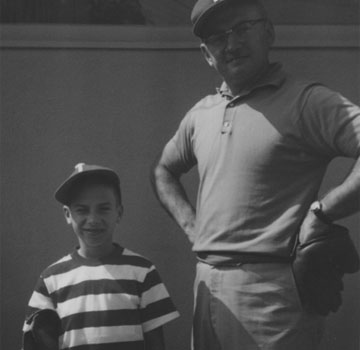


The California years proved to be the heyday of Roger’s card playing. Hard to believe that the Navy years could be eclipsed. Still, built in, family-based, bridge partners and opponents seldom required the addition of friends to make a game, although when the need arose, neighbors and parish friends readily stepped in. Along the way, Roger picked up the nickname “Iron Duke” That nickname had been previously given to, and was sometimes still worn by, Roger’s brother-in-law R.L. Davidson, husband of sister Corrine. R.L. stood as Roger’s best man at the Lamoureux wedding. But R.L. earned the name on the golf course, so Roger did not mind borrowing it at the bridge table.
Given his Navy-based card playing experiences, the Chief (as he was also sometimes known) played an intuitive and calm game of cards. He was never easily bluffed, in fact, he was probably never bluffed at cards, and seldom in everyday life.
In bridge, one sometimes tries to “finesse” the way that the hands proceed by drawing out the trump cards held by other players so that a trump card that you hold, that is lower than your opponent’s highest trump card, turns into a winner after your opponent wastes their higher cards on tricks that could have been won with a lower trump. Roger seldom if ever fell for a finesse and when one was attempted (and foiled), the comment that followed (sometimes spoken by his partner but usually pronounced by my father himself) was: “Not past the Iron Duke you don’t.”

One of the things that distinguishes living in Southern California is the ever-present threat and reality of earthquakes. Evangeline was a very proud, busy, competent, intelligent woman. North Dakota raised, Midwest tough, Navy-wife tested, the woman was not easily cowed by any man nor by most situations. She was long a coffee drinking, cigarette smoking, Midwestern-style housewife. She could sometimes, however, be somewhat jittery. Maybe it was the coffee. When the earth started to move, she’d head for the nearest doorway and stand there with both hands pressed hard against the inside of the frame, left and right, eyes as big as saucers. The North Dakota earth of her youth only moved under a plow.
When the quakes found us in bed, from the room down the hall I’d hear her hop out of their bed and rush to her bedroom doorway, only for her submarine-tempered husband to soon call out “Evangeline, come back to bed, relax, it’s only an earthquake, lay back and enjoy it, we don’t have them very often!”
Roger loved life in both the Navy and the Postal Service. And the 38 years of government service provided a more important benefit than he ever imagined. I remember seeing my father sitting in his LAZBOY opening his first retirement check and hollering to my mother, in the kitchen, “Evangeline, after 38 years of government service, they are paying me more to sit around and not work than they ever paid me to work. This is the biggest check I’ve ever gotten!”
Roger’s last score card.
10-4-85
US Naval Golf Course.“Then” Cerritos;“Now”
Cypress, CA
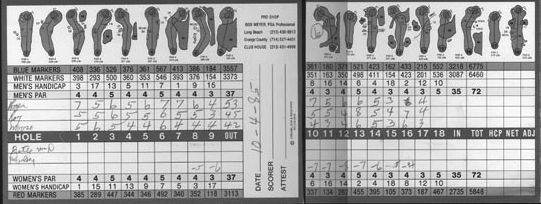
The fall of 1985, when we moved to Peoria to start my first teaching job after earning the Ph.D., my father passed away. He had a heart attack while playing golf. He didn’t feel particularly well that day, but had played (and walked, pulling his clubs with a two-wheel cart) 17 holes on a hot fall day. He teed off on 18, got to his ball, and called his playing partner (with an electric cart) over for a ride to the clubhouse and his car in the parking lot. That’s the first and only time that my father “quit” a round of golf before finishing all 18 holes. He used to get madder than hell with me when I’d want to go in after 9 holes or when playing poorly. He held no truck with “quitters,” especially when one had paid to play 18. Rog might have broken 100 that day, heart attack or not.
